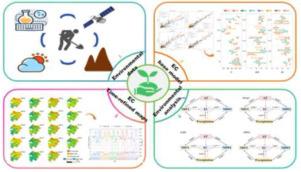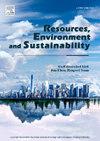季节性气候通过植被和水分调节驱动土壤盐分动态
IF 7.8
Q1 ENVIRONMENTAL SCIENCES
引用次数: 0
摘要
土壤盐碱化威胁着全球农业和生态系统,对可持续发展构成重大挑战。了解季节变化和环境因素如何影响盐度动态是必要的。然而,目前的研究严重依赖于单时间点遥感,这提供了有限的时间见解,未能揭示驱动季节变化的机制。本研究提出了基于动态时间翘曲的模型转移-结构方程模型(DBS)框架,将动态时间翘曲(DTW)、基本模型转移和结构方程模型(SEM)相结合,探讨环境因子对土壤盐分动态的调控机制。该框架包括建立堆叠电导率(EC)基础模型,将多个月的数据与DTW对齐,并通过SEM分析环境因素。主要预测因子为归一化植被指数(NDVI)、归一化水指数(NDWI)、气温(AT)和降水量。NDVI通过降低蒸发和稳定土壤水分来减少盐的积累,而NDWI则反映降水驱动的稀释和淋滤。温度通过调节NDVI和NDWI间接影响盐度。SEM证实NDVI和NDWI对EC有直接影响,而AT和降水对EC有间接影响。模型验证具有较高的准确性和适应性,训练模型的R-squared (R2)、Nash-Sutcliffe效率系数(NSE)和Kling-Gupta效率(KGE)值分别为0.93、0.94和0.89,验证模型的R-squared、Nash-Sutcliffe效率系数(NSE)和KGE值分别为0.86、0.85和0.79。DTW优化后,R2提高0.12-0.22,NSE提高0.07-0.18,KGE提高0.02-0.12,性能提升显著。该框架在不同土壤类型和植被覆盖下具有较强的迁移能力,R2为0.73 ~ 0.96,均方根误差(RMSE)为1 ~ 20,残差预测偏差(RPD)为1.22 ~ 1.95。该研究强调了气候-生态相互作用在盐度调节中的主导作用,并为多时间盐度预测提供了一个可靠的、可转移的方法。这些发现为精确的土壤盐渍化管理、可持续农业和气候适应战略提供了重要见解,特别是在易受盐渍化影响的地区。本文章由计算机程序翻译,如有差异,请以英文原文为准。

Seasonal climate drives soil salinity dynamics through vegetation and water regulation
Soil salinization threatens global agriculture and ecosystems, posing a critical challenge for sustainable development. Understanding how seasonal variations and environmental factors influence salinity dynamics is essential. However, current research relies heavily on single-time-point remote sensing, which offers limited temporal insights and fails to uncover the mechanisms driving seasonal changes. This study proposed the dynamic time warping-based model transfer-structural equation model (DBS) framework, which integrates dynamic time warping (DTW), base model transfer, and structural equation modeling (SEM), to explore the regulatory mechanisms of environmental factors on soil salinity dynamics. The framework includes building a stacking-electrical conductivity (EC) base model, aligning multi-month data with DTW, and analyzing environmental factors through SEM. Key predictors identified were normalized difference vegetation index (NDVI), normalized difference water index (NDWI), air temperature (AT), and precipitation. NDVI reduced salt accumulation by lowering evaporation and stabilizing soil moisture, while NDWI reflected precipitation-driven dilution and leaching. Temperature influenced salinity indirectly by regulating NDVI and NDWI. SEM confirmed NDVI and NDWI had direct effects on EC, while AT and precipitation acted indirectly. Model validation showed high accuracy and adaptability, with R-squared (R2), Nash–Sutcliffe efficiency coefficient (NSE), and Kling–Gupta Efficiency (KGE) values of 0.93, 0.94, and 0.89 for training and 0.86, 0.85, and 0.79 for validation, respectively. After DTW optimization, R2 improved by 0.12–0.22, NSE by 0.07–0.18, and KGE by 0.02–0.12, demonstrating significant performance gains. The framework demonstrated strong migration capability across different soil types and vegetation covers, achieving R2 of 0.73–0.96, The root mean squared error (RMSE) of 1–20, and residual prediction deviation (RPD) of 1.22–1.95. This study highlights the dominant role of climate-ecological interactions in salinity regulation and offers a robust, transferable method for multi-temporal salinity prediction. The findings provide critical insights for precision soil salinity management, sustainable agriculture, and climate resilience strategies, particularly in regions vulnerable to salinization.
求助全文
通过发布文献求助,成功后即可免费获取论文全文。
去求助
来源期刊

Resources Environment and Sustainability
Environmental Science-Environmental Science (miscellaneous)
CiteScore
15.10
自引率
0.00%
发文量
41
审稿时长
33 days
 求助内容:
求助内容: 应助结果提醒方式:
应助结果提醒方式:


